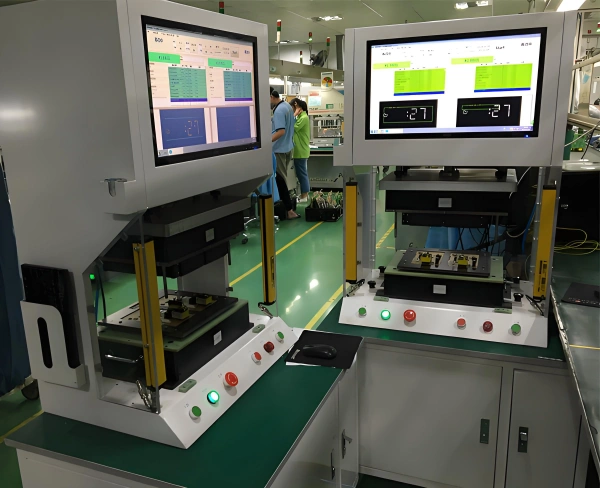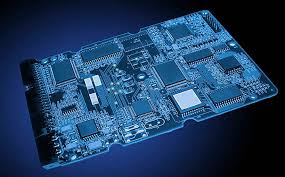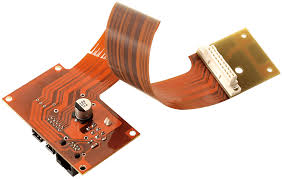External Visual Inspection
Manual Visual Inspection:
This involves using a magnifying glass or microscope to inspect the PCB surface for scratches, soldering defects, deformation, and other issues. Visual inspection is part of a broader visual check and is a manual testing method requiring experienced inspectors to use magnification tools to identify soldering defects and other visible flaws. This method is suitable for inspecting the PCB’s appearance, as poor solder mask application, component orientation, or scratches can lead to board failure.

Advantages:
- Low cost and easy to perform—no need for testing fixtures or complex setups.
- Most major soldering defects can be identified.
Disadvantages:
- Subject to human error, which may depend on the technician’s skill.
- Only visible solder joints can be inspected; hidden joints cannot be evaluated.
Automated Optical Inspection (AOI)
AOI can detect PCB faults or defects at an early development stage. AOI uses one (2D) or two (3D) cameras to capture high-resolution images of the PCB. These images are compared to detailed schematics or a database of good and bad board images to identify defects. AOI is often the first step in quality assurance, ensuring that problems are detected early and production is halted as soon as possible.


Various defect types can be detected, and if the board deviates from the schematic in any way, it is marked for further inspection by a technician. However, it is important not to rely solely on AOI. It should be used in conjunction with other tests. greatpcb recommends some combinations, including:
- AOI and Flying Probe Test.
- AOI and In-Circuit Testing (ICT).
- AOI and Functional Testing.
Advantages:
- Most major soldering defects can be identified.
- More consistent and accurate than manual visual inspection.
- Can be integrated directly into the production line for early defect detection.
Disadvantages:
- AOI is a passive inspection method—it can only detect surface defects. It has limited line of sight and cannot detect connections hidden under BGA or other types of packages.
- It is impossible to cover all part types 100%.
- Template matching setup and programming can be time-consuming, requiring reprogramming for each design change.
- Database-based matching may be less accurate depending on the quality of the database.
In-Circuit Testing (ICT)
PCBA ICT is currently the most powerful and popular type of PCBA testing for high-volume and mature products and is a well-trusted PCB testing method by many manufacturers and customers. Its fault coverage exceeds 95%. During PCBA ICT, an electrical probe in the form of a bed of nails sends current through specific locations on the PCB at designated test points. These tests verify the correct function, placement, orientation, and defects of each electronic component on the PCB. The tests include verification of parameters such as short circuits, open circuits, resistance, capacitance, and more. The bed of nails tester requires only pushing the PCB onto the probe bed to start testing. Access points are pre-designed on the board, allowing ICT test probes to connect to the circuitry.
For large-scale or repeat batches, a custom test fixture can be used for faster and more efficient in-circuit testing. This testing method is expensive, with costs depending on factors like the size of the board and the fixture. Therefore, it is strongly discouraged to change your mind and adopt an ICT strategy mid-production.
This testing method uses specialized PCB testing programs and equipment, including:
- In-Circuit Tester: A testing system containing a matrix of hundreds or thousands of drivers and sensors that perform measurements.
- Fixture: Connected to the in-circuit tester, this is the component that directly interacts with the PCB under test. This fixture resembles a bed of nails and is designed for the corresponding PCB. Each “nail” or sensor point is connected to the relevant point on the test board, feeding information back to the tester. The fixture is often the most expensive part of the system.
- Software: The tester’s software directs the system on what tests to perform on each board and indicates pass or fail parameters.
Advantages:
- Fault coverage can reach up to 98%.
- Efficient and fast testing method for mass-produced products.
Disadvantages:
- Test fixtures add an additional cost.
- Not suitable for small-scale production or prototyping, as any design changes require modifying/remaking the test fixture.
- Only test points can be accessed, requiring designers to add test points on the PCB.
- Certain defects, such as excess or insufficient solder and voids, cannot be evaluated.
Electrical Testing
1. Flying Probe Test
Similar in nature to traditional ICT, the Flying Probe Test is often considered an advanced version of the bed-of-nails ICT. Besides the designated test points, flying probe machines can access uncovered through-holes or the ends of components themselves as test points, and can be programmed to check the values of passive components, directly inspect the orientation of diodes/transistors, and measure voltage. It can quickly, conveniently, and economically adapt to new circuit boards through simple programming modifications. This makes it ideal for small-scale production testing and prototype testing, though it is slower and less cost-effective for mass production.

Flying Probe Test checks for:
- Open circuits
- Short circuits
- Reverse polarity
- Capacitance
- Inductance
- Diode issues
Advantages:
- Lower cost and faster to implement or modify. No fixtures are required.
- Higher test coverage—can use through-holes and component pads as test points.
- No need to add extra test points, saving board space.
Disadvantages:
- Too slow for large-scale testing.
- Certain defects, such as excess or insufficient solder and voids, cannot be evaluated.
2. In-Circuit Testing (ICT)
In-Circuit Testing (ICT) uses electrical performance testing equipment and online testers that do not break the circuit or remove components. It tests for shorts, opens, and the correctness of various electronic components such as resistors, capacitors, diodes, transistors, ICs, etc., identifying incorrect components, missing components, faulty parts, or assembly issues. It precisely points out the location of defects, helping users ensure product quality and improve the efficiency of defective product repairs.
The primary purpose of ICT is to ensure the physical connections and circuit performance of the PCBA are normal and to identify potential manufacturing defects. It focuses on testing the basic performance and connectivity of the circuit.

3. Functional Testing (FCT)
Building on ICT, Functional Testing (FCT) involves powering the circuit board under test and using functional test modules to complete a series of product functionality tests, such as testing LED modules, audio modules, IC programming, voltage measurement, communication testing, and more.

The main objective of FCT is to verify that all functions of the product are working correctly, ensuring that the product meets design requirements in real-world applications. FCT places more emphasis on the product’s performance and functionality in actual usage scenarios.
Environmental Testing
1. Temperature Cycling Test
PCBs are exposed to extreme high and low temperatures to test their reliability under temperature variations. Thermal testing is often conducted separately from humidity testing. These tests involve repeatedly changing the board’s temperature and examining how thermal expansion/contraction affects reliability. In thermal shock testing, the board is rapidly moved between two extreme temperatures using a dual-chamber system. Low temperatures are typically below freezing, while high temperatures are often above the substrate’s glass transition temperature (above ~130°C). Temperature cycling uses a single chamber where the temperature changes from one extreme to the other at a rate of 10°C per minute.
In both tests, the board will expand or contract as its temperature changes. During expansion, conductors and solder joints are subjected to high stress, which can accelerate the product’s lifecycle and help identify mechanical failure points.
2. Humidity and Corrosion Test
PCBs are tested under high humidity conditions to ensure their resistance to moisture, preventing circuit failures caused by moisture exposure. Since many PCBs will be deployed in humid environments, a common test for PCB reliability is moisture absorption testing. In this type of test, the PCB is weighed before and after being placed in a humidity-controlled environmental chamber. Any moisture absorbed by the board will increase its weight, and any significant weight change will lead to disqualification.
During these tests, exposed conductors should not corrode in humid environments. Copper, for instance, oxidizes easily when exposed to certain potentials, which is why exposed copper is usually plated with oxidation-resistant alloys. Examples include ENIG (Electroless Nickel Immersion Gold), ENIPIG (Electroless Nickel Immersion Palladium Immersion Gold), HASL (Hot Air Solder Leveling), nickel-gold, and nickel.
3. Highly Accelerated Testing
Highly Accelerated Testing includes Highly Accelerated Life Testing (HALT) and Highly Accelerated Stress Screening (HASS). These tests assess product reliability in controlled environments, including high temperatures, high humidity, and vibration/shock testing while the equipment is powered. The goal is to simulate conditions that might cause imminent failure in new products. During testing, the product is monitored in a simulated environment. Environmental testing for electronics typically includes testing within a small environmental chamber.
Mechanical Performance Testing
Mechanical performance refers to the mechanical characteristics exhibited by materials under various external loads (tensile, compressive, bending, torsional, impact, alternating stress, etc.) in different environments (temperature, medium, humidity).

| Category | Specific Items | Testing Significance |
|---|---|---|
| Hardness Test | Rockwell Hardness, Vickers Hardness, Micro Vickers Hardness, Brinell Hardness, Shore Hardness, Nanoindentation Hardness | Hardness refers to the characteristic of solid materials to resist permanent deformation. It is an indicator of a solid's ability to resist local intrusion by external objects, used to compare the hardness of various materials. |
| Tensile Test | Tensile Strength, Yield Strength, Elongation after Fracture, Reduction of Area, Elastic Modulus, Poisson's Ratio, Strain Hardening Index, Strain Hardening | The tensile test determines a series of strength and plasticity indicators for materials. Strength usually refers to the ability of a material to resist elastic deformation, plastic deformation, and fracture under external force. Plasticity refers to the ability of metallic materials to undergo plastic deformation without breaking under load. Common plasticity indicators are elongation and reduction of area. |
| Bending and Compression Performance | Bending Strength, Bending Modulus, Compression Strength, Compression Yield Point, Compression Elastic Modulus | The bending test is mainly used to determine the bending strength of brittle and low plasticity materials (such as cast iron, high carbon steel, tool steel, etc.) and reflect plasticity indicators. The bending test can also check the surface quality of materials. The maximum compressive load at failure, divided by the cross-sectional area of the specimen, is called the compressive strength limit or compressive strength. Compression tests are mainly applicable to brittle materials such as cast iron, bearing alloys, and construction materials. For plastic materials, it is impossible to measure compressive strength limits, but elastic modulus, proportional limit, and yield strength can be measured. |
| Impact Toughness Test | Impact Strength, Impact Toughness, Low Temperature Brittleness, Simply Supported Beam Impact, Cantilever Beam Impact | The impact toughness test measures the material's ability to resist impact loads. The practical significance of impact toughness indicators lies in revealing the material's tendency to become brittle. |
| Fracture Toughness Test | Fracture Toughness, Crack Tip Opening Displacement, Dynamic Fracture Toughness | Measures the ability of cracked components to resist crack instability and propagation. |
| Fatigue Performance | Symmetric Stress Fatigue, Asymmetric Cyclic Stress Fatigue, Strain Fatigue (Low-Cycle Fatigue), Fatigue Crack Growth Rate, Thermal Fatigue Test, Corrosion Fatigue Test, Contact Fatigue Test, High-Temperature Fatigue Test, Low-Temperature Fatigue Test | Fatigue tests, as part of structural testing, are used to study and verify the fatigue and fracture performance of aircraft structures or components. Fatigue failure is the primary form of early failure in mechanical parts. The main purpose of fatigue research is to accurately estimate the fatigue life of material structures and ensure that parts do not experience fatigue failure during their service life. |
| High-Temperature Mechanical Performance | High-Temperature Creep, Long-Term Strength, Stress Relaxation, High-Temperature Short-Time Tensile Test | At high temperatures, the ability of components to resist various deformations and stresses caused by external forces, such as strength, elasticity, and plasticity, is greatly influenced by the appearance, nature, quantity, and distribution of the liquid phase due to its presence at high temperatures. |
| Wear Resistance Performance | Wear Resistance Test | Wear resistance tests measure the amount of wear and friction coefficient of materials under given friction conditions. It is a type of material test that determines the wear resistance of materials and compares the relative wear resistance of materials. |
| Peel Strength | Tape Peel Strength, Peel Strength Test (Copper-Clad Laminate, PCB) | Peel strength refers to the force required to peel materials that are bonded together from the contact surface per unit width. The peeling angle can be 90 degrees or 180 degrees, with the unit being Newtons per meter (N/m). It reflects the bonding strength of materials. |
Chemical Testing
Ionic Contamination Testing
Ionic cleanliness typically refers to the ionic cleanliness of a circuit board. Various materials on a printed circuit board may leave ionic residues during the cleaning process, which can affect the functionality and reliability of electronic products. The most common issues caused by ionic contamination are surface corrosion and crystal growth, which eventually lead to short circuits, excessive current passing through connectors, and ultimately damage to electronic products.
Several contaminants primarily originate from processes such as electroplating, wave soldering, reflow soldering, and chemical cleaning. These include five forms of contamination: flux residues, ionized surface activators, ethanol, aminoethanol, and human sweat.
Ionic Cleanliness Testing Methods
- Anion-Cation Testing Method
The anion-cation method tests ionic cleanliness by applying a mixture of isopropanol and water in a specific ratio to soak the sample’s surface, dissolving contaminants into the solution. Then, by testing the types and amounts of anions, cations, and organic acids in the solution, the level of contamination is analyzed. The test results are typically expressed in μg/cm², with the testing standard referenced as IPC-TM-650, 2, 3, 28. The advantage of this method is that it provides a detailed understanding of the types and amounts of various ions. The IPC-TM-650, 2, 3, 28 standard specifies that the anion-cation method includes testing for six cations, seven anions, and eight organic acids:Cations: Lithium Ion, Sodium Ion, Ammonium Ion, Potassium Ion, Magnesium Ion, Calcium Ion
Anions: Fluoride Ion, Chloride Ion, Nitrite Ion, Bromide Ion, Nitrate Ion, Phosphate Ion, Sulfate Ion
Organic Acids: Acetic Acid, Adipic Acid, Formic Acid, Glutamic Acid, Malic Acid, Methanesulfonate, Succinic Acid, Phthalic Acid - Sodium Chloride Equivalent Method
The sodium chloride equivalent method uses ultrapure extraction solutions to remove residuals left from the manufacturing process on electronic components. The cleanliness result is measured based on conductivity or resistance coefficient. During the test, a solution prepared with pure 75% IPA (isopropanol) and 25% deionized water (by volume) is used as the extraction liquid. The PCB is placed in the extraction liquid, and the conductivity or resistance coefficient of the extraction liquid is measured after the contaminants dissolve, representing the level of contamination. Since the types of ionic contaminants vary, the sodium chloride equivalent concentration (expressed as μgEq NaCl/cm²) is used as the parameter representing the level of ionic contamination. The reference standard is IPC-TM-650, 2, 3, 25C. Compared to the anion-cation method, the disadvantage of this method is that it cannot clearly identify the types and amounts of ionic contamination.
Choosing the Testing Method
Generally, if you want to know the types and amounts of contaminants, it is recommended to choose the IPC-TM-650, 2, 3, 28 anion-cation method, which can clearly identify the source of contamination. For example, if the test results show high levels of F, Cl, or Br, the contamination source may be flux residues from wave soldering and reflow soldering processes; if the test results show high levels of organic acids, it may be due to contamination introduced during cleaning with ethanol or aminoethanol. The sodium chloride equivalent method lacks this advantage.
Solder Reliability Testing:
Tests the quality of solder joints, including the alloy composition of the solder, joint strength, soldering defects, etc.
X-ray Inspection
X-ray inspection utilizes a cathode ray tube to generate high-energy electrons that collide with a metal target. During the collision, the electrons lose kinetic energy, which is emitted in the form of X-rays. For areas of the sample that cannot be inspected visually, the contrast created by changes in light intensity as X-rays penetrate materials of different densities produces an image, revealing the internal structure of the item under inspection. This allows for the observation of problem areas within the sample without causing any damage.
X-ray inspection is widely used for defect detection of internal cracks, foreign objects, and displacement analysis in metal materials and components, plastic materials and components, electronic components, electronic assemblies, LED elements, and more. It can also identify soldering defects such as voids, insufficient soldering, and other issues in BGA, PCB, PCBA, and microelectronic systems, as well as internal conditions of encapsulated components, cables, fixtures, and plastic parts.
Applications:
Testing Procedure:
- Confirm sample type/material.
- Place the sample in the X-ray inspection device.
- Analyze the images obtained.
- Mark the types and locations of defects.
Standards Followed:
- IPC-A-610
- GJB 548B
Typical Images:


Impedance Testing
Impedance testing for PCBs involves measuring the resistance, inductance, capacitance, and other parameters of the conductive traces on the circuit board to evaluate the electrical performance of the board. Impedance testing is crucial for ensuring the quality and reliability of the circuit board. Firstly, impedance testing can identify potential issues in the circuit board design, such as improper trace layout or overly narrow conductor widths, allowing for timely adjustments and optimizations. Secondly, impedance testing ensures stable performance during high-frequency signal transmission, reduces signal attenuation and distortion, and improves the overall performance of the circuit board. Finally, impedance testing provides important data for quality control and troubleshooting, ensuring the stability and reliability of the circuit board during production and use.
Impedance Testing Principles
The principle of impedance testing is based on electromagnetic field theory and circuit analysis. During testing, specialized impedance testing instruments, such as impedance analyzers or network analyzers, are used to measure the conductive traces on the circuit board. The testing instrument sends a signal of a certain frequency to the circuit board and measures the transmission characteristics of the signal on the board, such as phase shift and amplitude attenuation, to calculate the impedance value of the conductive trace.
Impedance Testing Methods
There are two main methods for impedance testing: direct measurement and indirect measurement. Direct measurement involves applying voltage across and measuring current through the ends of the conductive trace to calculate the impedance value. This method is simple and straightforward but is significantly affected by the accuracy of the testing instrument and the measurement environment. Indirect measurement involves measuring the transmission characteristics of the conductive trace under high-frequency signals to infer the impedance value. This method can more accurately reflect the performance of the conductive trace under high-frequency signals but requires specialized testing instruments and software for analysis.
Electromagnetic Compatibility (EMC) Testing
Electromagnetic Compatibility (EMC) testing is a critical aspect of the development, production, and quality control of electronic products. It ensures that electronic systems or devices can operate normally in complex electromagnetic environments while not causing unacceptable electromagnetic interference to other systems or devices.
Test Conditions and Requirements
Test Methods:
According to IPC-J-STD-003, there are 5 test methods for solderability.
| Method | Applicable Scope | Evaluation Method | Remarks |
|---|---|---|---|
| Edge Dip Test | Surface conductors and pads | Appearance evaluation, cannot be quantified numerically | Commonly used method in the industry |
| Surface Mount Test | / | / | |
| Wave Solder Test | Surface conductors, pads, and plated-through holes | / | |
| Float Test | Plated-through holes and corresponding hole rings | / | Commonly used method in the industry |
| Wet Balance Test | Surface conductors, pads, and plated-through holes | Evaluation based on appearance, wetting time, and wetting force, can be quantified numerically | / |
Solder Requirements:
According to IPC-J-STD-006, lead-free testing uses SAC305 solder, with the following specific requirements:
SAC305 Solder Composition
| No. | Component | Weight Percentage (%) |
|---|---|---|
| 1 | Ag | 3.0±0.20 |
| 2 | Cu | 0.5±0.10 |
| 3 | Sn | 96.5±0.50 |
Solder Pot Impurity Control
| No. | Impurity | Maximum Allowable Weight Percentage (%) |
|---|---|---|
| 1 | Cu | 0.800 |
| 2 | Au | 0.200 |
| 3 | Cd | 0.005 |
| 4 | Zn | 0.005 |
| 5 | Al | 0.006 |
| 6 | Sb | 0.500 |
| 7 | Fe | 0.020 |
| 8 | As | 0.030 |
| 9 | Bi | 0.250 |
| 10 | Ag | 4.000 |
| 11 | Ni | 0.010 |
| 12 | Pb | 0.100 |
Flux Requirements
According to IPC-J-STD-003, lead-free testing uses Type 2 standard active rosin flux, with the following specific requirements:
| No. | Component | Weight Percentage (%) |
|---|---|---|
| 1 | Rosin | 25±0.5 |
| 2 | Diethylamine Hydrochloride | 0.39±0.01 |
| 3 | Isopropanol | Remaining balance |
| 4 | Chloride Equivalent Based on Solids | <0.5 |
| Note: The flux should be sealed and stored when not in use, discarded after 8 hours of use; or the flux density should be maintained at 0.843±0.005, temperature at (25±2)℃, and discarded after one week of use. | ||
Sample Requirements:
| No. | Sample Type | Sampling Location | Sampling Size |
|---|---|---|---|
| 1 | Surface conductors and pads | Locations that reflect the solderability characteristics of the PCB; for plated-through hole testing, the number of holes should be at least 30 | Standard requirement: not more than 50*50mm, industry norm: 50*50mm |
| 2 | Plated-through holes |
Test Conditions:
| No. | Test Method | Test Temperature | Test Time |
|---|---|---|---|
| 1 | Edge Dip Test | (255±5)℃ | (10±0.5)s |
| 2 | Float Test | ≥10s (related to sample thickness) |
Evaluation Standards:
| No. | Sample Type | Evaluation Area | Evaluation Standards |
|---|---|---|---|
| 1 | Surface conductors and pads | Do not evaluate within 3.2mm of the bottom edge of the sample and the areas where the sample holder makes contact | Each tested pad should have at least 95% of its area well wetted. Small pinholes, dewetting, surface roughness, etc., are allowed in the remaining area, but they must not be concentrated in one region. |
| 2 | Plated-through holes | Do not evaluate holes with cut edges | The hole wall should be completely wetted, with obvious wetting at the corners of the hole wall; the top-side hole ring may not be completely wetted. |







